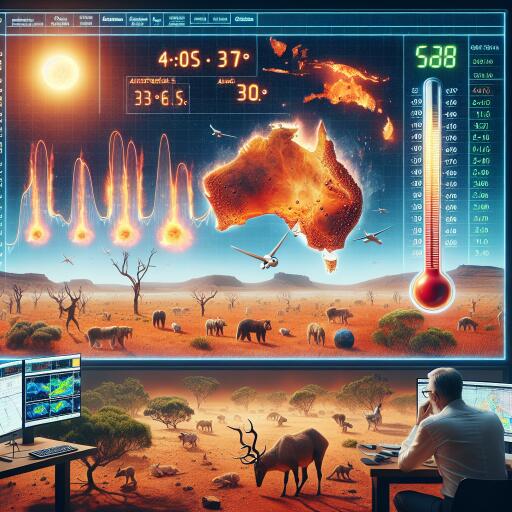
Australia’s Heat Wave Highlights Forecasting Accuracy
A pervasive heatwave developed over north and central Australia recently, with many regions preparing for their first encounter with intense summer temperatures exceeding 40°C since the notorious Black Summer of 2019-20. The southeast of Australia faced heightened alert due to the expected scorching heat accompanied by gusty winds, raising concerns about extreme fire conditions across South Australia, Victoria, and subsequently into New South Wales. As the heat intensified, vigilant observers would have noticed variations in the predicted temperatures in certain areas.
For instance, Melbourne’s forecast fluctuated significantly in the days leading up to an anticipated extreme heat event. Predictions ranged between approximately 35°C and 42°C, eventually settling at 41°C just days before the expected heatwave. This raised the question: would the day merely be very warm and manageable, or would it escalate into a highly unusual heatwave not experienced in years?
The Science of Weather Forecasting
Forecasting the future with precision is inherently challenging. Consider planning a day’s schedule for tomorrow; deviations from your plan, such as unexpected delays, could occur. Forecasting further ahead complicates matters even more, as numerous factors can influence outcomes. Weather forecasts operate similarly, relying on current atmospheric data worldwide to project future conditions using complex computer models.
These forecasts serve as a rough guide, especially those predicting 7-10 days ahead. Tiny, seemingly inconsequential discrepancies in atmospheric measurements can develop into significant changes in forecasts—a phenomenon known as the “butterfly effect.” As the prediction timeline extends, these errors compound.
To mitigate inaccuracies, forecasters conduct multiple model runs based on slightly varying atmospheric conditions. This generates an ensemble of forecasts, illustrating a spectrum of potential outcomes. The greater the consensus within these forecasts, the more confidence we have in the predicted weather.
Why Do Forecasts Change?
Changes in weather forecasts stem from the diverse range of potential outcomes represented in the ensemble of forecasts. Even minor shifts in predicted weather elements can significantly alter results. A closer examination of the extreme heat forecast for Melbourne highlights this complexity. Two primary factors influenced the exact temperature forecast: the timing of the cold front and cloud cover.
The anticipated arrival of a cold front was expected to conclude the high temperatures, but the timing was uncertain. If the cold front crossed in the afternoon, temperatures might peak in the mid to high 30s, whereas a delay until evening could push temperatures into the low 40s. Furthermore, cloud coverage played a significant role; more clouds could lower the temperature, while less cloud cover would allow for higher readings.
The official Bureau of Meteorology forecast projected a maximum temperature of 41°C for the broader Melbourne metropolitan area. However, while Geelong and the city’s western suburbs reached near that mark, the city and its eastern suburbs recorded slightly lower temperatures. A persistent cloud cover over the city center and eastern suburbs, contrasted by clearer skies to the west, contributed to this variation.
The Trustworthiness of Weather Forecasts
Despite inherent imperfections, weather forecasts are indeed valuable and reliable. Take this recent heat event, for example: forecasts indicated extreme heat over a week in advance, highlighting the possibility of a 40°C day for Melbourne as early as seven days out.
Two decades ago, predicting such an event with the current level of accuracy would have been deemed unattainable. The remarkable advancements in meteorology have made today’s seven-day forecasts as precise as the three-day forecasts from 40 years ago. This represents a significant scientific achievement.
Looking ahead to the festive season, forecasts suggest potential for more hot weather in the southeastern regions around Boxing Day, with some models indicating that Melbourne could once again reach temperatures in the 40s. As we approach this period, minor, nearly invisible inaccuracies may alter the current forecast. Irrespective of your preferred weather application, local forecasters are rigorously examining every possibility to deliver the most accurate predictions available.
Weather phenomena illustrate the intricate interplay of various environmental factors, and the challenges associated with their prediction emphasize the delicate balance humanity strikes with nature.





Leave a Reply